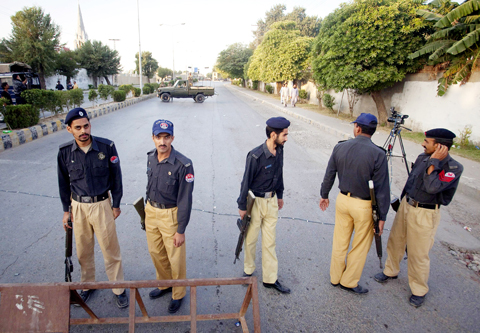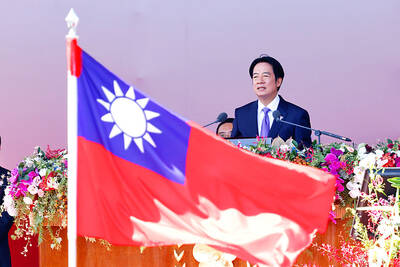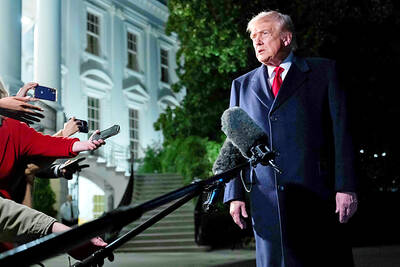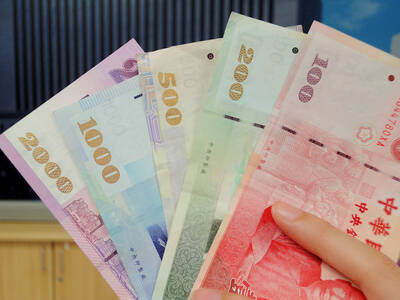Commandos stormed Pakistan’s army headquarters yesterday, ending a day-long hostage drama and freeing 39 people held by militants who brazenly struck at the heart of the military establishment.
Three hostages, two soldiers and four suspected Taliban militants were killed in a rescue operation hailed by the military as “highly successful” even though at least 19 people died in the assault.
Six soldiers and four other militants had already been killed in the nearly 24-hour siege, which began on Saturday in the garrison city of Rawalpindi and was the third dramatic militant strike in the nuclear-armed nation in a week.

PHOTO: REUTERS
The audacious attack exposed Pakistan’s vulnerability in the face of a Taliban militia that has regrouped after the death of its leader and is determined to thwart an army assault on tribal hideouts, analysts said.
In London, US Secretary of State Hillary Clinton said the attack showed the scale of the threat faced by Pakistan, but voiced confidence that the country’s nuclear weapons were properly secured.
Military spokesman Major General Athar Abbas said troops went in at about 6am and met resistance from five militants armed with suicide vests and barricaded in the building in the city, which adjoins Islamabad.
“Thirty-nine hostages were rescued and three were killed,” Abbas said, adding that the captives were shot dead by the militants. “The militants had suicide jackets, improvised explosive devices, grenades ... They wanted to blow up all the hostages and cause maximum damage.”
He said two soldiers and four of the insurgents were killed in the rescue operation. The leader of the militant team escaped and detonated a number of explosives before being injured and arrested.
“The operation is over. It was highly successful,” Abbas said.
He said that intelligence officials were investigating possible links between the sole surviving militant — named as Aqeel, also known as Doctor Usman — and the March attack on the Sri Lankan cricket team in Lahore.
The Rawalpindi attack bore similarities to the March gun-and-grenade attack, which left six policemen and two civilians dead. Abbas said the militant held yesterday had the same name and alias as one of the Lahore attack suspects.
The drama began just before midday on Saturday, when nine gunmen in military uniform and armed with automatic weapons and grenades drove up to the Rawalpindi compound and shot their way through a checkpoint.
Four militants and six soldiers were killed near a second post but the rest of the rebels fled and took the 42 military employees hostage.
There has been no claim of responsibility, but military and government officials blamed Taliban-linked militants.
On her visit to London, the US’ top diplomat, Clinton, said the attack was another reminder that Islamist extremists were “increasingly threatening the authority of the state” of Pakistan.
She said, however, that the US had “confidence in the Pakistani government and military’s control over nuclear weapons.”
The Tehreek-e-Taliban Pakistan (TTP) movement is based in the northwest tribal belt and is blamed for most of the attacks that have killed more than 2,200 people across Pakistan since July 2007.
The weekend siege came after a suicide car bomb on Friday killed at least 52 civilians at a busy market in the northwest city of Peshawar and an attack on a UN office in Islamabad last Monday left five aid workers dead.
The new Taliban leadership have vowed to avenge the death of their commander Baitullah Mehsud in a US drone missile attack in August, and are also keen to deter an assault on their stronghold, analysts say.
The military is wrapping up a fierce offensive against Taliban rebels in the northwestern Swat valley launched in April, with the army now poised to begin a similar assault in the nearby semi-autonomous tribal belt near Afghanistan.

People can preregister to receive their NT$10,000 (US$325) cash distributed from the central government on Nov. 5 after President William Lai (賴清德) yesterday signed the Special Budget for Strengthening Economic, Social and National Security Resilience, the Executive Yuan told a news conference last night. The special budget, passed by the Legislative Yuan on Friday last week with a cash handout budget of NT$236 billion, was officially submitted to the Executive Yuan and the Presidential Office yesterday afternoon. People can register through the official Web site at https://10000.gov.tw to have the funds deposited into their bank accounts, withdraw the funds at automated teller

PEACE AND STABILITY: Maintaining the cross-strait ‘status quo’ has long been the government’s position, the Ministry of Foreign Affairs said Taiwan is committed to maintaining the cross-strait “status quo” and seeks no escalation of tensions, the Ministry of Foreign Affairs (MOFA) said yesterday, rebutting a Time magazine opinion piece that described President William Lai (賴清德) as a “reckless leader.” The article, titled “The US Must Beware of Taiwan’s Reckless Leader,” was written by Lyle Goldstein, director of the Asia Program at the Washington-based Defense Priorities think tank. Goldstein wrote that Taiwan is “the world’s most dangerous flashpoint” amid ongoing conflicts in the Middle East and Russia’s invasion of Ukraine. He said that the situation in the Taiwan Strait has become less stable

REASSURANCE: The US said Taiwan’s interests would not be harmed during the talk and that it remains steadfast in its support for the nation, the foreign minister said US President Donald Trump on Friday said he would bring up Taiwan with Chinese President Xi Jinping (習近平) during a meeting on the sidelines of the APEC Summit in South Korea this week. “I will be talking about Taiwan [with Xi],” Trump told reporters before he departed for his trip to Asia, adding that he had “a lot of respect for Taiwan.” “We have a lot to talk about with President Xi, and he has a lot to talk about with us. I think we’ll have a good meeting,” Trump said. Taiwan has long been a contentious issue between the US and China.

FRESH LOOK: A committee would gather expert and public input on the themes and visual motifs that would appear on the notes, the central bank governor said The central bank has launched a comprehensive redesign of New Taiwan dollar banknotes to enhance anti-counterfeiting measures, improve accessibility and align the bills with global sustainability standards, Governor Yang Chin-long (楊金龍) told a meeting of the legislature’s Finance Committee yesterday. The overhaul would affect all five denominations — NT$100, NT$200, NT$500, NT$1,000 and NT$2,000 notes — but not coins, Yang said. It would be the first major update to the banknotes in 24 years, as the current series, introduced in 2001, has remained in circulation amid rapid advances in printing technology and security standards. “Updating the notes is essential to safeguard the integrity